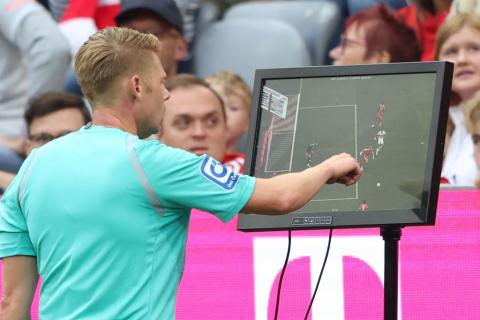Dribbling may seem like a simple part of football, but it’s where many players struggle. With icons like Lionel Messi making dribbling look effortless, it’s clear this skill is no child’s play.
Our guide walks you through the whys and hows of mastering dribbles to elevate your game. Discover the secrets behind those mesmerising runs down the pitch!
The Purpose and Essence of Dribbling in Football
Dribbling in football serves multiple purposes, including maintaining possession, creating space for teammates, and drawing defenders away from key areas. It is an essential skill for attacking midfielders, strikers, and wingers who need to beat opponents one-on-one and set up goal-scoring opportunities.
Maintaining Possession
Holding onto the ball is crucial in football, as it allows a team to control the pace of the game. Skilled players like Neymar and Mbappe display exceptional dribbling skills that help them keep possession even when tightly marked by defenders.
Their ability to twist, turn and pull off deft feints means opponents are less likely to tackle successfully.
This aspect of play isn’t just about individual flair; it’s a strategic tool for teams. Good possession reduces the opponent’s opportunities to attack and increases your own team’s chances of scoring.
Attacking midfielders and wingers expertly use speed dribbling to glide past challenges, keeping the ball well within their team’s grasp while looking for openings to advance towards goal or safely pass it on to a teammate.
Also Read: How Do Strikers Score More Goals by Developing Killer Instincts?
Creating Space
Creating space on the pitch is like a magician making room where none seems to exist. Skilled dribblers use their quick feet and sharp turns to open up the field, allowing for that crucial pass or shot which can change the course of a game.
Every touch of the ball has potential; it’s an invitation for team members to move into new positions and create opportunities for attack. This movement confuses defenders, forcing them to make split-second decisions that could result in mistakes or penalties.
Players who excel at creating space are invaluable during counterattacks, breaking away from midfields cluttered with tackles and potential red cards. They draw defenders out, leaving gaps behind for teammates to exploit.
By mastering this art, footballers keep opponents on their toes and lay down foundations for direct free kicks and penalty chances – elements critical in tight matches where every moment counts towards victory or defeat.
Drawing Defenders
After mastering the ability to create space, players can escalate their influence by drawing defenders away from their teammates. The art of dribbling isn’t just about retaining possession; it’s a chess-like tactical move used to entice opponents out of position.
Skilled footballers leverage this tactic, committing defenders and causing disarray within the defensive structure. This strategic ploy opens up game-changing opportunities for passes or shots at goal that wouldn’t exist without those deft movements.
Dribblers who excel in captivating defenders’ attention truly understand the dynamics of soccer tactics. They possess an intuitive grasp of timing and use their technical skills to coax multiple opponents towards them, thereby creating numerical advantages elsewhere on the pitch.
Their calculated runs paired with ball control are essential tools in bending matches toward favourable outcomes without necessarily having to run down the clock through time-wasting strategies.
The Role of Dribbling in Game Management and Time-Wasting

Dribbling in football isn’t just about dazzling footwork or navigating past opponents; it’s a strategic tool for controlling the pace of the game. Experienced players use dribbling to manage time effectively, especially when leading towards the end of a match.
Holding onto the ball with skilful moves forces opponents to chase and can draw out precious seconds off the clock, giving your team an advantage.
Skilled dribblers don’t rush at every opportunity; they know when to slow down play and keep possession. This tactic frustrates opposing teams, disrupting their rhythm and decreasing their chances to score.
As fans cheer on these nail-biting moments, dribblers maintain composure under pressure — demonstrating why mastery over the ball is essential for controlling outcomes on the pitch.
With this understanding of game management through dribbling, next we delve into different types of dribbling techniques that players employ to become masters of manipulation with the ball at their feet.
Different Types of Dribbling Techniques
- The Nutmeg: This cheeky move involves tapping the ball through an opponent’s legs and quickly retrieving it on the other side. It’s a daring skill that requires timing and audacity but can leave defenders humiliated.
- The Stepover: Players use this technique to confuse or freeze defenders by stepping over the ball one or multiple times before taking it in another direction. It’s effective for creating space to advance or shoot.
- The Body Feint: A simple yet deceptive move where a player fakes a direction with their body or head to trick a defender into committing one way while moving the ball in another. Balance and body control are essential here.
- La Croqueta: Popularised by Spanish playmakers, this elegant manoeuvre involves sliding the ball from one foot to the other to bypass an approaching opponent. It’s favoured in close quarters on the field.
- The Maradona Turn, or Roulette: Named after Diego Maradona, players execute this spin by rolling the ball with one foot onto the other and spinning 360 degrees to evade tackles. Strength and dexterity are key.
- The Pullback V: By dragging the ball back with the sole of their boot then quickly pushing it sideways into open space, players perform a swift change of direction to shake off pursuers.
Conclusion
Dribbling stands as the cornerstone of football, a skill that sets dynamic players apart. It’s not just about keeping the ball; it’s a creative force on the pitch. Players with adept dribbling abilities turn matches around and inspire teams to victory.
They navigate through challenges with exceptional footwork and control. True success in football often hinges on this intricate dance with the ball at one’s feet.
FAQs
1. What makes dribbling a crucial skill in football?
Dribbling is essential in football because it allows players to navigate through the opposition, maintain possession and create scoring opportunities on the field, becoming key for successful plays.
2. How does dribbling contribute to a footballer’s overall performance?
Through expert dribbling, a footballer can outwit defenders with skilful manoeuvres, control the game’s pace and open up spaces for teammates, which ultimately uplifts their contribution to the team.
3. Can mastering dribbling impact a team’s strategy during a match?
Indeed, when players excel at dribbling, it adds an unpredictable element to the team’s attack strategy and helps break down tough defences by drawing opponents out of position.
4. Why should young footballers invest time in improving their dribble?
Improving their dribble equips young footballers with better ball control under pressure, increases their confidence during challenging encounters on the pitch and advances their overall gameplay significantly.


